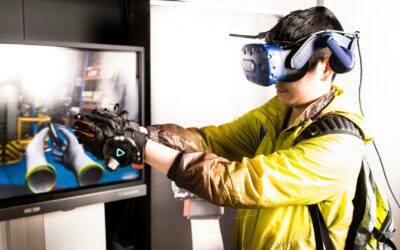The Metaverse: Internet’s Next Frontier
The metaverse is the next evolution of the Internet and promises to merge the physical world with augmented and virtual realities (AR/VR). The brainchild of Neal Stephenson’s 1992 dystopian thriller “Snow Crash,” the prefix “meta” means beyond while “verse” refers to the universe. Stephenson’s book features a protagonist who delivers pizza yet possesses an uncanny ability to transform himself into a warrior prince chasing down hackers and other cyber villains. The metaverse also draws inspiration from Eric Cline’s futuristic sci-fi novel “Ready Player One” (later a movie directed by Steven Spielberg) about a search for an elusive Easter egg leading to untold fortunes. A little farfetched but suspend reality for a moment and imagine putting on a head-mounted display, viewing lifelike computer imagery, and becoming completely immersed with fellow avatars in an interactive world and digital communal cyberspace.
Today the metaverse is commonly associated with virtual video games powered by Facebook’s Oculus Quest 2 headsets and simulation software such as Journey of the Gods, Half-Life: Alyx, and Onward. Indeed, Facebook recently changed its name to Meta Platforms to highlight how strategic the metaverse is to the company’s future direction. Not to be outdone, Apple just acquired Activision for a whopping $75 billion to ascend into the metaverse. Google, Microsoft (HoloLens), Nvidia (Omniverse), and Roblox are also exploring ways to further develop metaverse computing platforms not only for gaming but for other applications, too (more on this later).
Imagine a fully embodied 3D internet that you experience on the inside (commonly referred to as web 3.0) rather than viewing from outside a two-dimensional computer screen. VR transports you to a virtual world while AR overlays digital elements in the tangible world. Epic Games was the first to introduce this concept in a meaningful way when it rolled out “Fortnite” in 2017. An earlier and cruder version of virtual spaces known as the “Second Life” was rolled out almost twenty years ago allowing avatars to create another life in an online, virtual world. Although critics at the time suggested that “SecondLife” was for those who struggled with their first, the application was a precursor for what we are seeing today.
While it is in the early innings and its trajectory unknown, the metaverse will link together disparate digital assets and integrate them into a single virtual environment, adding an entirely new dimension to our economy based on the new types of data extracted from these platforms. Bloomberg Intelligence estimates that the value of the metaverse will reach $800 billion by the middle 2020s and $2.5trillion by 2030. Just think of it as a network of virtual worlds in the same way the World Wide Web is a network of interconnected computers. Of course, privacy and security concerns loom at the forefront of the metaverse’s development (e.g., Big Tech’s imperceptible use of biometrics to extract user data) and widespread consumer acceptance may be slow in coming especially among non-gamers. Creating standards and interoperability are other hurdles in terms of allowing users to apply their digital identities across multiple computer platforms. Sociologists have voiced concerns that online addicts today need less screen time and more personalized, face-to-face interaction. Escapist illusions combined with the pandemic may have hindered our communication skills and human capacity to remain empathetic toward one another. The visceral fear is that simulated reality may one day become indistinguishable from the real world. Imagine how deep fakes have already thrown the world into an epistemological crisis.
Beyond gaming, manufacturers are exploring the interdisciplinary nature underlying the metaverse and applying a software-first approach to their enterprises and supply chains, too. Digital twins, plant simulation software, collaborative office spaces for remote workers, and other immersive 3Denvironments all aim to help business and industry become more agile, adaptable, and efficient. For example, using Microsoft HoloLens two employees can quickly learn complex tasks and collaborate in the moment from anywhere in the world. In addition, Nvidia describes its end-to-end Omniverse platform as a metaverse for engineers because it enables them to design, iterate, simulate, and visualize in real time a virtual factory floor using a shared 3D virtual space. Both examples allow manufacturers to harvest critical process data, compress their product development cycles and accelerate speed to market of their new products, services, and technologies. These digitally driven platforms will also reduce downtime, transform workforces, build more flexible factories, and make supply chains more transparent and resilient to consumer demand. In the end, the metaverse will significantly raise the global competitiveness of manufacturing and other industries in a sustainable way—all while lifting world living standards, too.
Noel Nevshehir is director of Automation Alley’s International Business Services and Global Strategic Partnerships. In this role, Nevshehir is responsible for leading Automation Alley’s trade mission program and foreign direct investment efforts. He is also responsible for seeking out global strategic partners that align with Automation Alley’s Industry 4.0 mission.




